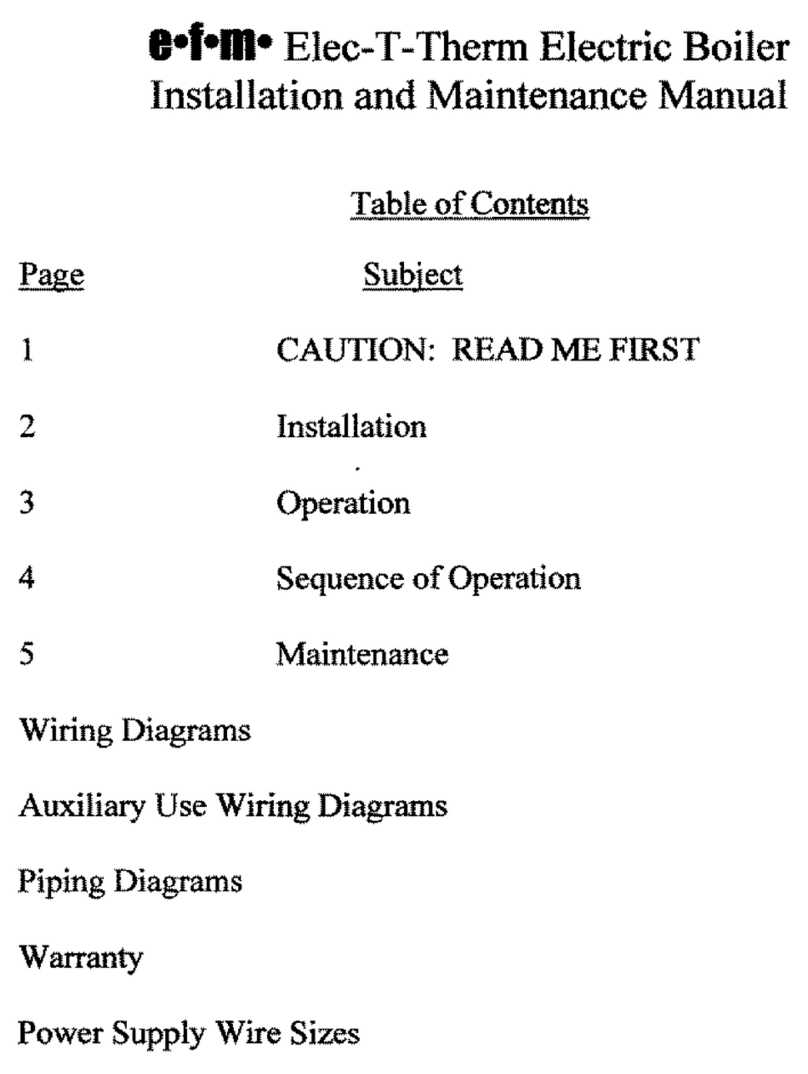
4
shown in the burner manual provided along
with this manual. Burner settings are listed
on the Service Man’s Label attached to the
boiler and on the Burner Unit specifications
provided along with this manual.
6) Install pressure gauge in the 1/8" gauge port
of the oil pump.
7) Turn on switch to start burner. If burner does
not start immediately, you may need to reset
the burner control. See the burner manufac
turers instructions for control and reset
features.
8) On one pipe systems bleed the oil pump as
soon as burner motor starts. To bleed, attach
a length of 1/4" O.D. clear plastic tubing to
the end of the bleed plug and then loosen
plug while holding an empty container under
the tubing to catch all of the expelled oil.
Bleed for at least 15 seconds after the oil
stream is free of all air. If air is still evident in
the bleed line you must check the oil lines,
all fittings, filters and any other connections
for tightness. inks in the oil lines will create
undue high vacuum therefore they must be
eliminated. When you are sure all air has
been eliminated then close the bleed valve.
Ignition should be instantaneous following
the closing of this valve. If it is not good,
proceed to the trouble shooting guide in the
burner manufacturer’s manual to determine
why the oil did not ignite.
9) FINAL ADJUSTMENTS OF THE BURNER
MUST BE MADE USING PROPER COM-
BUSTION TEST EQUIPMENT. The air supply
should be adjusted by loosening the lock
screw and moving the bulk air band or shut-
ter so that the CO2measured in the stack
ahead of the draft control should be a mini-
mum of 10% and a maximum of 12%. At the
same time the draft should be adjusted to
negative .01"- negative .02" W.C. over the
fire. Install a second barometric draft control
if necessary to reduce excessive draft. The
smoke should also be checked with a smoke
gun and found to be zero.
10) Check operation of the cad cell relay by
removing one cad cell wire from external
terminal during the flame cycle. The relay
should cut the burner off in approximately 15
to 45 seconds, depending on the control
provided. See the burner manufacturers
manual provided in the data pack.
Servicing the Boiler/Burner Unit
1) Burner Components: If replacement of burn-
er parts is necessary, always use parts rec-
ommended by the manufacturer. Specify part
number and description when ordering.
2) Electrode settings are important for reliable
ignition of the oil. Check to be sure the set-
tings are in accordance with the instructions
provided in the burner manual.
3) Nozzles: The nozzle specifications listed in
the manual are the result of years of exhaus-
tive engineering testing. ANY NOZZLE
REPLACEMENT SHOULD BE OF THE
EXACT TYPE AS LISTED IN THE SPECIFI-
CATIONS. Use extreme care in handling noz-
zles to avoid scratches or dirt that could
cause leaks or affect the oil spray pattern.
4) Fan and blower housing should be kept
clean of dirt and lint. If heating unit is located
near an unvented dryer, special care must be
taken so that lint does not clog the burner air
inlets.
5) Replace the oil filter cartridge annually.
6) Cleaning the Boiler: Cleaning should be done
only by a trained, experienced serviceman.
Turn power off to the boiler. To clean the
boiler, remove the flue pipe, jacket top and
flue collector. Remove the baffles then clean
the tubes with a soft 2" flue brush. Reinstall
parts, readjust and clean the burner if
required.”
CAUTION
Si ce this u it utilizes a fiber combustio chamber
the careful use of a soft flue brush is highly
recomme ded. I additio , be especially careful
whe clea i g the chamber with a vacuum
clea er.
Instructing the Homeowner
The operation and care of the heating system
should be explained to the homeowner, including
the simple checks to make before calling for ser-
vice if the burner fails to operate automatically.


























